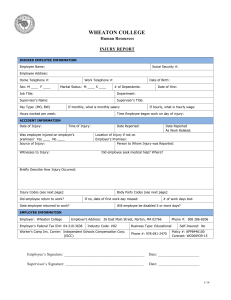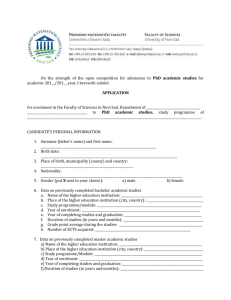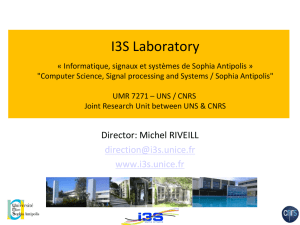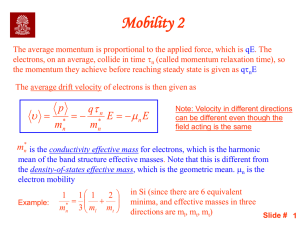L14-11339_Piccione_RevisedSUP_rev2
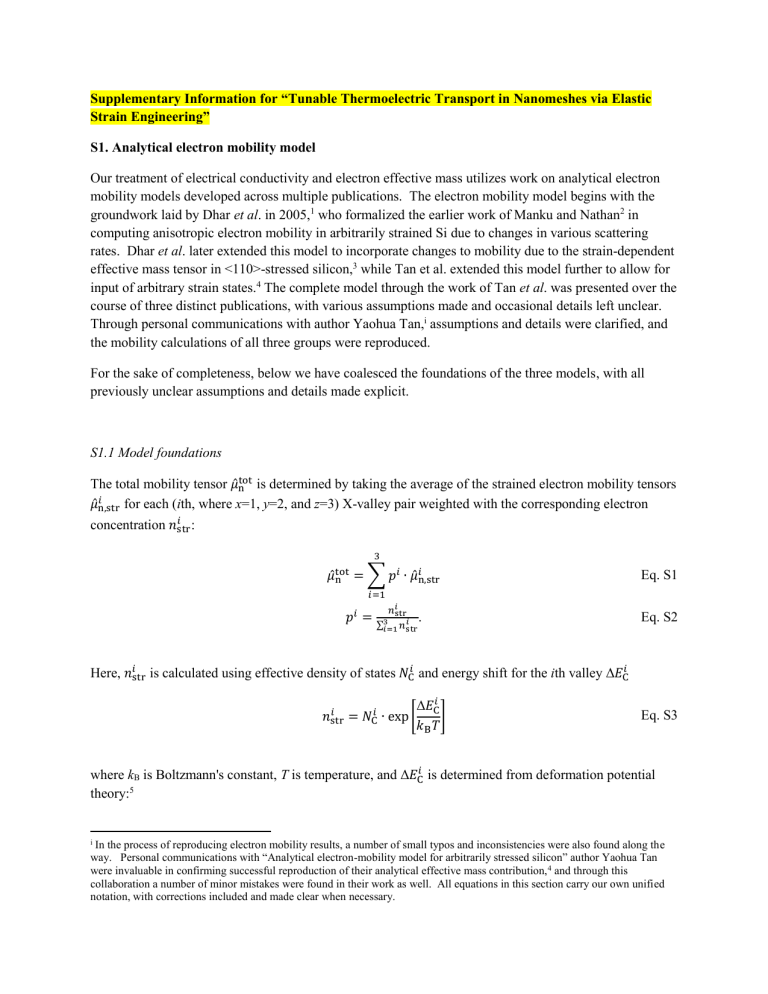
Supplementary Information for “Tunable Thermoelectric Transport in Nanomeshes via Elastic
Strain Engineering”
S1. Analytical electron mobility model
Our treatment of electrical conductivity and electron effective mass utilizes work on analytical electron mobility models developed across multiple publications. The electron mobility model begins with the groundwork laid by Dhar et al . in 2005, 1 who formalized the earlier work of Manku and Nathan 2 in computing anisotropic electron mobility in arbitrarily strained Si due to changes in various scattering rates. Dhar et al . later extended this model to incorporate changes to mobility due to the strain-dependent effective mass tensor in <110>-stressed silicon, 3 while Tan et al. extended this model further to allow for input of arbitrary strain states.
4 The complete model through the work of Tan et al . was presented over the course of three distinct publications, with various assumptions made and occasional details left unclear.
Through personal communications with author Yaohua Tan, i assumptions and details were clarified, and the mobility calculations of all three groups were reproduced.
For the sake of completeness, below we have coalesced the foundations of the three models, with all previously unclear assumptions and details made explicit.
S1.1 Model foundations
The total mobility tensor 𝜇̂ tot n
is determined by taking the average of the strained electron mobility tensors 𝜇̂ 𝑖 n,str
for each ( i th, where x =1, y =2, and z =3) X-valley pair weighted with the corresponding electron concentration 𝑛 𝑖 str
:
3 𝜇̂ tot n
= ∑ 𝑝 𝑖
∙ 𝜇̂ 𝑖 n,str 𝑝 𝑖
= 𝑖=1
∑ 𝑛
3 𝑖=1 𝑖 str 𝑛 𝑖 str
.
Eq. S1
Eq. S2
Here, 𝑛 𝑖 str
is calculated using effective density of states 𝑁 𝑖
C
and energy shift for the i th valley Δ 𝐸 𝑖
C 𝑛 𝑖 str
= 𝑁 𝑖
C
∙ exp[
Δ 𝐸 𝑘
B 𝑖
C
𝑇
] Eq. S3 where k
B
is Boltzmann's constant, T is temperature, and Δ 𝐸 𝑖
C
is determined from deformation potential theory: 5 i In the process of reproducing electron mobility results, a number of small typos and inconsistencies were also found along the way. Personal communications with “Analytical electron-mobility model for arbitrarily stressed silicon” author Yaohua Tan were invaluable in confirming successful reproduction of their analytical effective mass contribution, 4 and through this collaboration a number of minor mistakes were found in their work as well. All equations in this section carry our own unified notation, with corrections included and made clear when necessary.
Δ 𝐸 𝑖
C
= Ξ d
(ε
1
+ ε
2
+ ε
3
) + Ξ u
ε 𝑖
Eq. S4 using dilation and shear deformation potentials Ξ d
= 1.13 eV and Ξ u
= 10.5 eV with ε 𝑖
components of the strain tensor in matrix notation. The effective densities of state for each valley are defined by:
𝑁
C 𝑖
= 2 (
2𝜋𝑚 ℎ 𝑖 c
2 𝑘
B
𝑇
) Eq. S5 where h is Plank's constant and 𝑚 𝑖 c
is the conductivity effective electron mass for the i th valley, given below in Section S1.3. Finally, the mobility tensors for each valley pair are assumed products of scalar
( 𝜇 𝑖 n,str
) and effective mass ( 𝑚 𝑖(−1)
) contributions, spelled out as: 𝜇̂ 𝑖 n,str
(𝑁
I
, ∆𝜀 𝑖
) = 𝜇 𝑖 n,str
∙ 𝑚 𝑖(−1) Eq. S6 where: 𝜇 𝑖 n,str
= 𝛽∙𝜇
L
1+(𝛽−1)∙ℎ 𝑖 𝑠𝑐𝑎𝑡
+𝛽( 𝜇L 𝜇LI
−1)
, with variables defined below in section S1.2.
Eq. S7
S1.2 Scattering parameters
The scattering quotient is grounded firmly in Matthiessen's Rule 6 incorporating scattering from multiple sources, in this case, intra- and intervalley scattering between equivalent valleys ( g -type, at rate 𝜏 equiv
(−1)
), intervalley scattering between nonequivalent valleys ( f -type, at rate (𝜏 neq
( Δ 𝐸 𝑖
C
))
(−1)
), and impurity scattering, at rate 𝜏
I
(−1)
. 𝛽 = (𝑓 ∙ 𝑚 t,uns
)/(𝑚 c,uns
) Eq. S8 where 𝑚 t,uns
and 𝑚 c,uns
are the transverse and conductivity effective masses along a principle axis for unstrained intrinsic Si and f is an "enhancement factor" effectively quantifying the ratio of g -type to f -type scattering. 𝑚 c,uns
is assumed equal to the harmonic mean of the transverse and longitudinal effective masses: 𝑚 c,uns
=
3
2 𝑚t,uns
+
1 𝑚l,uns
Eq. S9 with m t,uns
=0.19
m
0
and m l,uns
=0.918
m
0
.
Though Dhar et al . left the precise value of f unspoken in this study 1 and its follow-up, 3 we confirmed through model reproduction that in assuming strain-induced valley splitting is large enough such that the lowest valley is fully populated and intervalley scattering to higher valleys is suppressed, the f used in confirming the validity of their model with first-principles results was that obtained in the limit 𝜏 equiv
<< 𝜏 neq
: 𝑓 = 𝑚 c,uns
/𝑚 t,uns
Eq. S10 𝜇 L
is the electron mobility for undoped Si and 𝜇 LI
is the mobility of majority electrons in doped Si, given by: 𝜇
L
= 1430 cm 2 /V-s Eq. S11 and 𝜇
LI
= 𝜇 L −𝜇 mid maj 𝜂
1+( 𝑛A
𝐶maj
)
+ 𝜇 mid maj
−𝜇 hi maj 𝜂
1+( 𝑛A
𝐶maj
)
+ 𝜇 hi maj
Eq. S12 where 𝑛
A
𝐶 mid maj
is carrier concentration, with constants
= 2.22 × 10 17
cm -3 and 𝐶 hi maj as " 𝐶 mid
" in Dhar et al . Eq. 30.
1
𝜂 = 0.65, 𝜇 mid maj
= 44 cm 2 /V-s, 𝜇 hi maj
= 57 cm 2 /V-s,
= 1.18 × 10 20
cm -3 included here to correct the mislabeling of 𝐶 mid maj ℎ 𝑖 𝑠𝑐𝑎𝑡
is a dimensionless factor relating intervalley scattering rates in strained silicon to intervalley scattering rates in unstrained silicon, given by: ℎ 𝑖 𝑠𝑐𝑎𝑡
= 𝑔 (
Δ 𝑖𝑗emi 𝑘
B
𝑇
) + 𝑔 (
Δ 𝑘 𝑖𝑙emi
B
𝑇
) + exp ( ℏ𝜔 𝑘
B opt
𝑇
) [𝑔 (
Δ 𝑘 𝑖𝑗abs
B
𝑇
) + 𝑔 (
Δ 𝑘 𝑖𝑙abs
B
𝑇
)]
2 [𝑔 (− ℏ𝜔 opt 𝑘
B
𝑇
) + Γ (
3
2)]
Eq. S13 where:
Δ 𝑖𝑗emi
= ∆𝐸 𝑗
C
− ∆𝐸 𝑖
C
− ℏ𝜔 opt
Eq. S14
Δ 𝑖𝑗abs
= ∆𝐸 𝑗
C
− ∆𝐸 𝑖
C
+ ℏ𝜔 opt and 𝑔(𝑧) = { exp(−𝑧) ∙ Γ (3/2) exp(−𝑧) ∙ Γ (3/2, −𝑧)
∀𝑧 > 0
∀𝑧 < 0
,
Eq. S15
Eq. S16 included here to make explicit a correction to a typo in Dhar et al . Eq. 20.
1 In Eq. S13, ħω opt
is the optical phonon energy, equal to 60 meV at room temperature. In Eq. S16, Γ (3/2) = ( √𝜋 /2) and Γ (3/2, −𝑧) denotes the incomplete Gamma function.
S1.3 Effective mass tensor
To explicitly take into account the effect of strain-dependent electron effective mass, Dhar et al . furthered the above model 1 by first modifying the Tan et al . electron energy dispersion relation to explicitly include shear strain effects on band warping using a very similar methodology to that first laid out by Hensel et al ., 7 applicable near the bottom of the Δ
2
conduction valley:
𝐸 𝑖 (𝜀, 𝑘) = ℏ 2
2𝑚
0
( 𝑘 𝑗
2
+ 𝑘 𝑚 𝑖∗ t
2 𝑘
+ 𝑘 𝑖
2 𝑚 l 𝑖∗
) +
(𝛼 + 𝛽𝜀
2 𝑗𝑘
) 𝑘 𝜀 𝜀 𝑗𝑘 𝑘 𝑗 𝑘 𝑘
+ Δ 𝐸 𝑖
C
Eq. S17 where 𝛼 , 𝛽 , and k
ε
are fit parameters obtained from comparison to results from nonlocal empirical pseudopotential method calculations (equal to 669.5 eV, -2.65x10
6 eV and 0.076 2π/a
0
, respectively), and 𝑚 𝑖∗ t
and 𝑚 l 𝑖∗
are the transverse and longitudinal effective electron masses for the i th valley pair, respectively. In the case of the z valley pair in particular, changes to the effective mass along [110]
( 𝑚 t
[110]∗
) can be expressed in terms of the transverse effective mass for unstrained silicon ( 𝑚 ∗ t,uns
) from
Eq. S17, yielding: 𝑚 t
̅0]∗
(−1)
= 𝑚 ∗ (−1) t,uns
±
(𝛼+𝛽𝜀
2 𝑥𝑦
)𝜀 𝑥𝑦 𝑘
2 𝜀 𝑚 ℏ 2
0
.
Eq. S18
Similarly, 𝑚 t
= 𝑚 ∗ (−1) t,uns
±
(𝛼+𝛽𝜀
2 𝑥𝑧
)𝜀 𝑥𝑧 𝑘 2 𝜀 𝑚
0 ℏ 2
,
Eq. S19 and 𝑚 t
(−1)
= 𝑚
∗ t,uns
(−1)
±
(𝛼+𝛽𝜀
2 𝑦𝑧
)𝜀 𝑦𝑧 𝑘
2 𝜀 𝑚
0 ℏ 2
,
Eq. S20
Simple matrix rotation lays plain what Dhar et al . left unsaid, that is, inverse effective mass tensors for all three valley pairs expressed in terms of the i th transverse ( 𝑚 𝑖 t
), longitudinal ( 𝑚 𝑖 l
), and conductivity ( 𝑚 𝑖 c
) effective masses: 𝑚
1(−1)
= 𝑚
1 c 𝑚
∗ (−1) l,uns
0
( 0
0 𝑚
∗ t,uns
(−1)
∆𝑚
1(−1) t
0
∆𝑚
1(−1) t 𝑚
∗ (−1) t,uns
) 𝑚
2(−1)
= 𝑚
2 c 𝑚 ∗ t,uns
(−1)
0
( ∆𝑚 t
2(−1)
0 𝑚
∗ (−1) l,uns
0
∆𝑚 t
2(−1)
0 𝑚
∗ t,uns
(−1)
)
Eq. S21
Eq. S22
𝑚
3(−1)
= 𝑚
3 c 𝑚
∗ t,uns
(−1)
∆𝑚 t
3(−1)
( 0
∆𝑚
3(−1) t 𝑚
∗ (−1) t,uns
0
0
0 𝑚
∗ (−1) l,uns
)
Eq. S23 where: 𝑚
1 c
= ( 𝑚 [011]∗
(−1)
+ 𝑚
̅1]∗
(−1)
3
+ 𝑚
1 l,uns
∗(−1)
)
(−1)
∆𝑚
1 t
= ( 𝑚 [011]∗
(−1)
− 𝑚
2
̅1]∗
(−1)
)
(−1) 𝑚
2 c
= ( 𝑚
∆𝑚 2 t
[101]∗
(−1)
+ 𝑚
= ( 𝑚
[101]∗
(−1)
̅]∗
(−1)
3
+ 𝑚
2 l,uns
∗(−1)
)
(−1)
− 𝑚
2
̅]∗
(−1)
)
(−1) 𝑚
3 c
= ( 𝑚 [110]∗
(−1)
+ 𝑚
̅0]∗
(−1)
3
+ 𝑚
3 l,uns
∗(−1)
)
(−1)
∆𝑚
3 t
= ( 𝑚
[110]∗
(−1)
− 𝑚
2
̅0]∗
(−1)
)
(−1)
Eq. S24
Eq. S25
Eq. S26
Eq. S27
Eq. S28
Eq. S29
Using Eqs. S21-23 to define effective mass tensors in conjunction with the scalar mobilities calculated from Section S1.2, one can potentially obtain the complete mobility tensor for silicon under an arbitrary strain state and refer the tensor to a coordinate system of interest to obtain mobility along the direction of interest.
S2. Equivalent circuit model.
Global electrical conductivity of each nanomesh is obtained using the volume filament 8 /RL ladder 9 lumped model method, where a continuum material is modeled as an equivalent circuit of discrete elements. Using finite element analysis, a DC voltage is first applied across the nanomesh, and volume filaments of equal current are determined in the analysis (Fig. S1(a)). Each filament is then modeled as resistors in series, with the resistance of each element determined by evaluating the electron mobility model in Section S1 for the local strain state at that node as given from finite element analysis of the same structure under remote stress. The resultant equivalent circuit (Fig. S1(b)) is a convenient, flexible model for evaluating global nanomesh electrical conductivity and comparing between structures.
(a) (b)
Figure S1: Simplified depiction of volume filament lumped model. a) Continuum nanomesh geometry divided into four discrete volume filaments of equal current, with width and spatial definition of filaments determined from finite element analysis. b) Nanomesh equivalent RL circuit used in global electrical conductivity evaluations. Each resistor is one node in the finite element model, and resistance values at each node are determined using the electron mobility model described in Section S1.
S3. Effect of stress state on electron transport.
Mechanisms causing different global electrical conductivities for square and diamond lattice types (main text Fig. 5) may not be immediately obvious upon first glance at Fig. 3. Figure 2 shows that
-1 enhancement in bulk silicon is strongest when the direction of transport and principal stress are aligned, with a gradual reduction in enhancement as their dot product approaches zero. Fig. S2 shows spatiallyresolved dot products of electrical current and 1st principal stress plane normals in square and diamond nanomesh structures under
∞ =1 GPa along [110]. These plots lay plain that in the diamond nanomesh structure, transport and 1st principal stress are misaligned to a greater degree as a whole than in the square structure. Current travelling through the diamond structure is forced through a region where the dot product drops significantly, while current travelling through the square structure stays largely along the right and left edges of the unit cell where misalignment is at a minimum. These differences between the two lattice types are exaggerated further as porosity is increased, leading to the greater disparity in
-1 illustrated in Fig. 5.
(a) (b)
Figure S2 :Spatially-resolved dot product of electrical current and 1st principal stress directions for square
(a) and diamond (b) lattice structures under 1GPa remote uniaxial load for 22% porosity, with voltage and stress applied along [110].
S4. Stress as a function of porosity.
(a) (b)
Figure S3 : Illustrations showing (a) the schematic superposition of stress fields as a function of porosity and (b) the maximum principal strains as a function of porosity for
∞ =1 GPa. As porosity increases, both the extent of strain fields, as well as the maximum local principal strains, increase.
S4. Software details.
1
2
3
6
7
4
5
8
9
10
We used the COMSOL Multiphysics software package for meshing and finite element analysis.
The stationary solver was used on a free triangular mesh. The solid mechanics (solid) and electric currents (ec) modules were used, with the elasticity tensor for single-crystalline silicon at room temperature obtained from Reference
10
. Isocurrent lines and local strain tensors extracted from this analysis were used as input in the numerical electrical conductivity and thermopower numerical model. The numerical model was implemented in Mathematica, with additional processing for Fig. 3 in the main text performed in MATLAB.
Works Cited
S. Dhar, H. Kosina, V. Palankovski, S. E. Ungersboeck, and S. Selberherr, IEEE Trans. Elec.
Dev. 52 , 527-533 (2005).
T. Manku and A. Nathan, IEEE Trans. Elec. Dev. 39 , 2082-2089 (1992).
S. Dhar, E. Ungersbock, H. Kosina, T. Grasser, and S. Selberherr, IEEE Trans. Nano. 6 , 97-100
(2007).
Y. Tan, X. Li, L. Tian, and Z. Yu, IEEE Trans. Elec. Dev. 55 , 1386-1390 (2008).
I. Balslev, Phys. Rev. 143 , 636 (1966).
A. Matthiessen and C. Vogt, Phil. Trans. R. Soc. 154 , 167-200 (1864).
J. C. Hensel, H. Hasegawa, and M. Nakayama, Phys. Rev. 138 A225-A238 (1965).
S. Mei and Y. I. Ismail, IEEE Trans. VLSI 12 , 437-447 (2004).
S. Kim and D. P. Neikirk, IEEE MTT-S 3 1815-1818 (1996).
M. A. Hopcroft, W. D. Nix, and T. W. Kenny, J. Microelecmech. Sys. 19 , 229-238 (2010).
